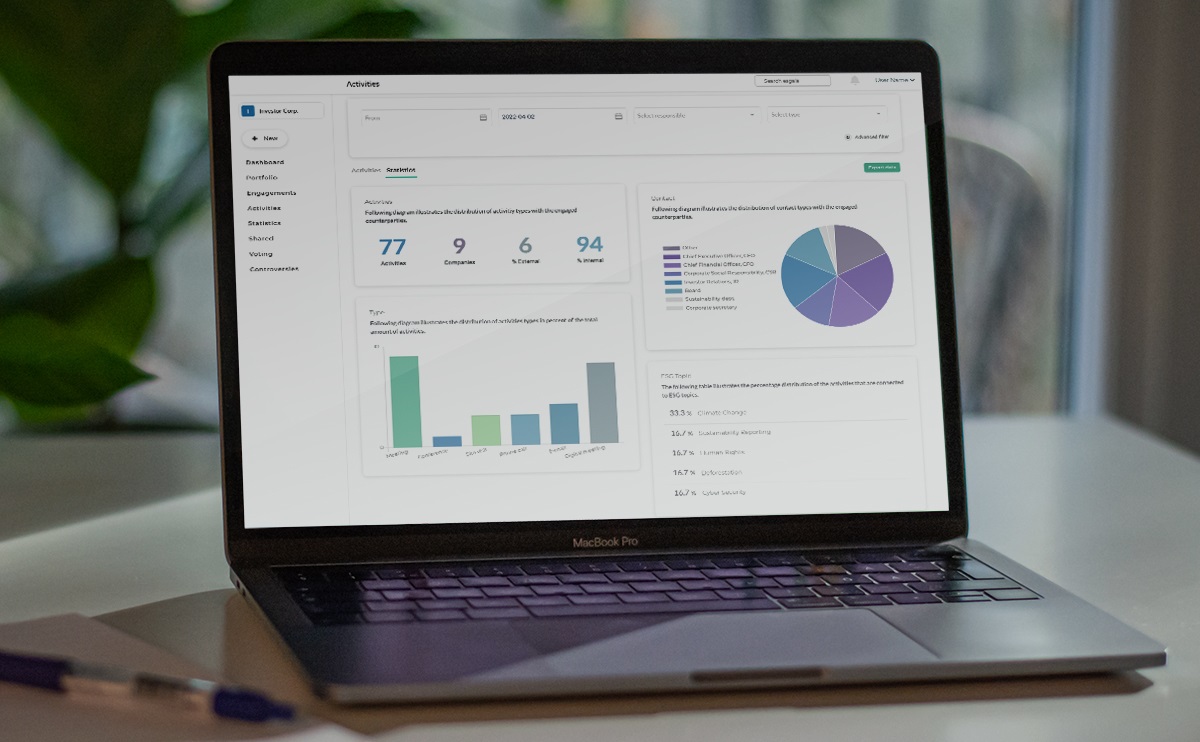Guest Post – ESG Engagement Tracking: From Challenges to Best Practices
By: Rickard Nilsson, Director, Strategy & Growth, Esgaia
Investors that demonstrate engagement best practices ensure that their stewardship activities are adequately resourced, including their investment in people, processes, research, and systems. However, establishing a smooth workflow to avoid suboptimal use of resources can be difficult. Investors should therefore holistically assess process efficiency and system capabilities.
Today, engagement activities are characterized by a range of enablers and barriers to engagement success[1], such as challenges to adequately record, monitor, and evaluate progress. Unless well-executed, this can undermine the ability to influence corporates and become a hindrance to successful engagements, in turn leading to a lack of positive engagement outcomes of increased financial returns[2], reduced downside risks[3], and sustainable real-world impact[4].
In this article, we take aim at primary challenges and how to overcome those in order to successfully operationalise the engagement process. Focus elements include coordination and information access, stewardship reporting, system integrations, and more.
The increasing complexity of engagement strategies
Managing a growing number of engagement dialogues and activities creates different challenges across organisations. For example, with investment professionals displaying varying interest and knowledge levels in ESG and engagement, how should you ensure proper oversight and consistency in practices over time?
Progressive investors understand that the key to ensuring a well-functioning process – operational or system-wise – spells thoughtful consideration. Importantly, system capabilities should help structure and optimise engagement recording, monitoring and reporting. Using a cloud-based environment for such would be a wise first step towards greater transparency and consistency in activities across teams.
Effectivizing stewardship reporting
Investors are facing growing expectations around their stewardship disclosures, both in regards to policies and strategies, as well as scope and scale of activities. Yet, almost everyone we talk to struggles with this to some extent. Many will recognize when I say that reporting tends to be a burdensome effort that often leads to suboptimal use of resources, especially if data is fragmented and unstructured, and there are incomplete records of interactions.
What investors should want here is for data collection to be automated and accessible via a dashboard for analytics and extraction across entity, product, and engagement level. Combine this with your engagement objectives and prioritisation, and you should then be able to support best-in-class reporting that promotes a cause and effect relationship between ESG research and tools, investment beliefs and engagement with issuers[5].
Focus on the user experience
An unconsidered approach to engagement tracking will result in various inefficiencies. In legacy structures, it might be difficult to for example properly monitor engagements, and keep track of status and next steps, which in turn can lead to a lot of administrative work to simply assess time lapse since last contact, when a new action should be taken, and so forth.
Point being that regardless of the specifics here, focusing on the user experience serves multiple purposes, including positioning for changing practices and scalability over time. Reasonably then, investors would strive for;
- dedicated functionality and strong visual design for organisational alignment through ease of use and support of main use cases,
- user research for systems development – a SaaS solution is particularly powerful here given insights to best practices across multiple organisations,
- utility-based design improvements by considering user data to find potential inefficiencies, bottlenecks, etc.
System integrations are essential
Achieving an optimal balance between adequate activity levels, efficiency and quality is not an easy task. Investors should partly consider information access to minimise workflow disruption, however today, many struggles with this because they utilize a siloed system approach to risk/research management, ESG research, and engagement.
Engagement tracking capabilities should enable integrations with internal and third-party systems. In doing so – automating access to and provision of certain data between systems -, it will reduce admin and internal information asymmetry, while improving team capacity and quality.
Enhancing internal and external collaboration
Investors should demonstrate an integrated process to active ownership across teams, and use collaboration to increase influence. However, common issues around fragmentation of data and version management risk leading to uncertainty around engagement ownership and status, next steps, and so forth.
To empower collaboration, many would therefore benefit from facilitating technology that improves transparency and information sharing. This could be solved in a cloud-based environment with functionality such as; user ownership; user-specific rights for team governance and accountability; ability to share and watch engagements, and; external party access for collaboration.
A couple of concluding remarks
Supporting software should empower investors to optimize the engagement process to increase their influence and real-world impact.
I hope this article can help you better reflect on current capabilities and future needs of your organisation. To help you on the way, Esgaia has developed a generic engagement tracker checklist, or cheat sheet if you will, – in excel, accounting for ease of use – which you can access here. Or access our website www.esgaia.com for more information.
About the author:
Rickard Nilsson, Spokesperson and Director, Strategy & Growth at Esgaia. With years of experience in responsible investing, Rickard focuses on market intelligence and outreach, and promotion of industry best practices. He is passionate about all things esg, especially investment stewardship and how engagement can help advance sustainability practices.
[1] https://www.unpri.org/download?ac=4151
[2] https://papers.ssrn.com/sol3/papers.cfm?abstract_id=2154724
[3] https://papers.ssrn.com/sol3/papers.cfm?abstract_id=2874252
[4] https://www.researchgate.net/publication/329600669_Beyond_Returns_Investigating_the_Social_and_Environmental_Impact_of_Sustainable_Investing
[5] https://www.frc.org.uk/getattachment/42122e31-bc04-47ca-ad8c-23157e56c9a5/FRC-Effective-Stewardship-Reporting-Review_November-2021.pdf





